7235c331d65b5f41940219b4ec5d10b9.ppt
- Количество слайдов: 61
 Modelling the FX Skew Dherminder Kainth and Nagulan Saravanamuttu Qua. RC, Royal Bank of Scotland
Modelling the FX Skew Dherminder Kainth and Nagulan Saravanamuttu Qua. RC, Royal Bank of Scotland
 2 Overview o FX Markets o Possible Models and Calibration o Variance Swaps o Extensions
2 Overview o FX Markets o Possible Models and Calibration o Variance Swaps o Extensions
 3 FX Markets o Market Features o Liquid Instruments o Importance of Forward Smile
3 FX Markets o Market Features o Liquid Instruments o Importance of Forward Smile
 4 Spot
4 Spot
 5 Volatility
5 Volatility
 6 European Implied Volatility Surface • Implied volatility smile defined in terms of deltas • Quotes available – Delta-neutral straddle ⇒ Level – Risk Reversal = (25 -delta call – 25 -delta put) ⇒ Skew – Butterfly = (25 -delta call + 25 -delta put – 2 ATM) ⇒ Kurtosis • Also get 10 -delta quotes • Can infer five implied volatility points per expiry – ATM – 10 delta call and 10 delta put – 25 delta call and 25 delta put • Interpolate using, for example, SABR or Gatheral
6 European Implied Volatility Surface • Implied volatility smile defined in terms of deltas • Quotes available – Delta-neutral straddle ⇒ Level – Risk Reversal = (25 -delta call – 25 -delta put) ⇒ Skew – Butterfly = (25 -delta call + 25 -delta put – 2 ATM) ⇒ Kurtosis • Also get 10 -delta quotes • Can infer five implied volatility points per expiry – ATM – 10 delta call and 10 delta put – 25 delta call and 25 delta put • Interpolate using, for example, SABR or Gatheral
 7 Risk-Reversals
7 Risk-Reversals
 8 Implied Volatility Smiles
8 Implied Volatility Smiles
 9 Liquid Barrier Products • Some price visibility for certain barrier products in leading currency pairs (eg USDJPY, EURUSD) • Three main types of products with barrier features – Double-No-Touches – Single Barrier Vanillas – One-Touches • Have analytic Black-Scholes prices (TVs) for these products • High liquidity for certain combinations of strikes, barriers, TVs • Barrier products give information on dynamics of implied volatility surface • Calibrating to the barrier products means we are taking into account the forward implied volatility surface
9 Liquid Barrier Products • Some price visibility for certain barrier products in leading currency pairs (eg USDJPY, EURUSD) • Three main types of products with barrier features – Double-No-Touches – Single Barrier Vanillas – One-Touches • Have analytic Black-Scholes prices (TVs) for these products • High liquidity for certain combinations of strikes, barriers, TVs • Barrier products give information on dynamics of implied volatility surface • Calibrating to the barrier products means we are taking into account the forward implied volatility surface
 10 Double-No-Touches • Pays one if barriers not breached through lifetime of product FX rate U S L 0 T time • Upper and lower barriers determined by TV and U×L=S 2 • High liquidity for certain values of TV : 35%, 10%
10 Double-No-Touches • Pays one if barriers not breached through lifetime of product FX rate U S L 0 T time • Upper and lower barriers determined by TV and U×L=S 2 • High liquidity for certain values of TV : 35%, 10%
 11 Double-No-Touches • For constant TV, barrier levels are a function of expiry
11 Double-No-Touches • For constant TV, barrier levels are a function of expiry
 12 Single Barrier Vanilla Payoffs • Single barrier product which pays off a call or put depending on whether barrier is breached throughout life of product • Three aspects – Final payoff (Call or Put) – Pay if barrier breached or pay if it is not breached (Knock-in or Knock-out) – Barrier higher or lower than spot (Up or Down) • Leads to eight different types of product • Significant amount of value apportioned to final smile (depending on strike/barrier combination) • Not as liquid as DNTs
12 Single Barrier Vanilla Payoffs • Single barrier product which pays off a call or put depending on whether barrier is breached throughout life of product • Three aspects – Final payoff (Call or Put) – Pay if barrier breached or pay if it is not breached (Knock-in or Knock-out) – Barrier higher or lower than spot (Up or Down) • Leads to eight different types of product • Significant amount of value apportioned to final smile (depending on strike/barrier combination) • Not as liquid as DNTs
 13 One-Touches • Single barrier product which pays one when barrier is breached • Pay off can be in domestic or foreign currency • There is some price visibility for one-touches in the leading currency markets • Not as liquid as DNTs • Price depends on forward skew
13 One-Touches • Single barrier product which pays one when barrier is breached • Pay off can be in domestic or foreign currency • There is some price visibility for one-touches in the leading currency markets • Not as liquid as DNTs • Price depends on forward skew
 14 Replicating Portfolio B K Spot
14 Replicating Portfolio B K Spot
 15 Replicating Portfolio u
15 Replicating Portfolio u
 16 Replicating Portfolio u
16 Replicating Portfolio u
 17 One-Touches • For Normal dynamics with zero interest rates • Price of One-Touch is probability of breaching barrier • Static replication of One-Touch with Digitals
17 One-Touches • For Normal dynamics with zero interest rates • Price of One-Touch is probability of breaching barrier • Static replication of One-Touch with Digitals
 18 One-Touches • Log-Normal dynamics • Barrier is breached at time • Can still statically replicate One-Touch
18 One-Touches • Log-Normal dynamics • Barrier is breached at time • Can still statically replicate One-Touch
 19 One-Touches • Introduce skew • Using same static hedge • Price of One-Touch depends on skew
19 One-Touches • Introduce skew • Using same static hedge • Price of One-Touch depends on skew
 20 Model Skew • Model Skew : (Model Price – TV) • Plotting model skew vs TV gives an indication of effect of model-implied smile dynamics • Can also consider market-implied skew which eliminates effect of particular market conditions (eg interest rates)
20 Model Skew • Model Skew : (Model Price – TV) • Plotting model skew vs TV gives an indication of effect of model-implied smile dynamics • Can also consider market-implied skew which eliminates effect of particular market conditions (eg interest rates)
 21 Possible Models and Calibration o Local Volatility o Heston o Piecewise-Constant Heston o Stochastic Correlation o Double-Heston
21 Possible Models and Calibration o Local Volatility o Heston o Piecewise-Constant Heston o Stochastic Correlation o Double-Heston
 22 Local Volatility • Local volatility process • Ito-Tanaka implies • Dupire’s formula
22 Local Volatility • Local volatility process • Ito-Tanaka implies • Dupire’s formula
 23 Local Volatility Calibration to Europeans
23 Local Volatility Calibration to Europeans
 24 Local Volatility • Gives exact calibration to the European volatility surface by construction • Volatility is deterministic, not stochastic • • implies spot “perfectly correlated” to volatility Forward skew is rapidly time-decaying
24 Local Volatility • Gives exact calibration to the European volatility surface by construction • Volatility is deterministic, not stochastic • • implies spot “perfectly correlated” to volatility Forward skew is rapidly time-decaying
 25 Local Volatility Smile Dynamics ΔS
25 Local Volatility Smile Dynamics ΔS
 26 Heston Model • Heston process • Five time-homogenous parameters • Will not go to zero if • Pseudo-analytic pricing of Europeans
26 Heston Model • Heston process • Five time-homogenous parameters • Will not go to zero if • Pseudo-analytic pricing of Europeans
 27 Heston Characteristic Function • Pricing of European options • Fourier inversion • Characteristic function form
27 Heston Characteristic Function • Pricing of European options • Fourier inversion • Characteristic function form
 28 Heston Smile Dynamics ΔS
28 Heston Smile Dynamics ΔS
 29 Heston Implied Volatility Term-Structure
29 Heston Implied Volatility Term-Structure
 30 Implied Volatility Term Structures
30 Implied Volatility Term Structures
 31 Piecewise-Constant Heston Model • Process • Form of reversion level 0 • 1 W 1 M 2 M 3 M Calibrate reversion level to ATM volatility term-structure time
31 Piecewise-Constant Heston Model • Process • Form of reversion level 0 • 1 W 1 M 2 M 3 M Calibrate reversion level to ATM volatility term-structure time
 32 Piecewise-Constant Heston Characteristic Function • Characteristic function • Functions satisfy following ODEs (see Mikhailov and Nogel) • and independent of
32 Piecewise-Constant Heston Characteristic Function • Characteristic function • Functions satisfy following ODEs (see Mikhailov and Nogel) • and independent of
 33 Piecewise-Constant Heston Calibration to Europeans
33 Piecewise-Constant Heston Calibration to Europeans
 34 DNT Term Structure
34 DNT Term Structure
 35 Stochastic Volatility/Local Volatility • Possible to combine the effects of stochastic volatility and local volatility • Usually parameterise the local volatility multiplier, eg Blacher
35 Stochastic Volatility/Local Volatility • Possible to combine the effects of stochastic volatility and local volatility • Usually parameterise the local volatility multiplier, eg Blacher
 36 Stochastic Risk-Reversals • USDJPY 6 month 25 -delta risk-reversals USDJPY (JPY call) 6 M 25 Delta Risk Reversal 2. 2 2. 0 1. 8 1. 6 1. 4 1. 2 1. 0 0. 8 0. 6 0. 4 Risk Reversal 2. 2 26 Nov 06 21 Nov 05 08 Nov 04
36 Stochastic Risk-Reversals • USDJPY 6 month 25 -delta risk-reversals USDJPY (JPY call) 6 M 25 Delta Risk Reversal 2. 2 2. 0 1. 8 1. 6 1. 4 1. 2 1. 0 0. 8 0. 6 0. 4 Risk Reversal 2. 2 26 Nov 06 21 Nov 05 08 Nov 04
 37 Stochastic Correlation Model • Introduce stochastic correlation explicitly but what process to use? • Process has to have certain characteristics: – Has to be bound between +1 and -1 – Should be mean-reverting • Jacobi process • Conditions for not breaching bounds
37 Stochastic Correlation Model • Introduce stochastic correlation explicitly but what process to use? • Process has to have certain characteristics: – Has to be bound between +1 and -1 – Should be mean-reverting • Jacobi process • Conditions for not breaching bounds
 38 Stochastic Correlation Model • Transform Jacobi process using • Leads to process for correlation • Conditions
38 Stochastic Correlation Model • Transform Jacobi process using • Leads to process for correlation • Conditions
 39 Stochastic Correlation Model • Use the stochastic correlation process with Heston volatility process • Correlation structure
39 Stochastic Correlation Model • Use the stochastic correlation process with Heston volatility process • Correlation structure
 40 Stochastic Correlation Calibration to Europeans and DNTs Loss Function : 14. 303
40 Stochastic Correlation Calibration to Europeans and DNTs Loss Function : 14. 303
 41 Stochastic Correlation Calibration to Europeans and DNTs
41 Stochastic Correlation Calibration to Europeans and DNTs
 42 Multi-Scale Volatility Processes • Market seems to display more than one volatility process in its underlying dynamics • In particular, two time-scales, one fast and one slow • Models put forward where there exist multiple time-scales over which volatility reverts • For example, have volatility mean-revert quickly to a level which itself is slowly mean-reverting (Balland) • Can also have two independent mean-reverting volatility processes with different reversion rates
42 Multi-Scale Volatility Processes • Market seems to display more than one volatility process in its underlying dynamics • In particular, two time-scales, one fast and one slow • Models put forward where there exist multiple time-scales over which volatility reverts • For example, have volatility mean-revert quickly to a level which itself is slowly mean-reverting (Balland) • Can also have two independent mean-reverting volatility processes with different reversion rates
 43 Double-Heston Model • Double-Heston process • Correlation structure
43 Double-Heston Model • Double-Heston process • Correlation structure
 44 Double-Heston Model • Stochastic volatility-of-volatility • Stochastic correlation
44 Double-Heston Model • Stochastic volatility-of-volatility • Stochastic correlation
 45 Double-Heston Model • Pseudo-analytic pricing of Europeans • Simple extension to Heston characteristic function
45 Double-Heston Model • Pseudo-analytic pricing of Europeans • Simple extension to Heston characteristic function
 46 Double-Heston Parameters • Two distinct volatility processes – One is slow mean-reverting to a high volatility – Other is fast mean-reverting to a low volatility – Critically, correlation parameters are both high in magnitude and of opposite signs
46 Double-Heston Parameters • Two distinct volatility processes – One is slow mean-reverting to a high volatility – Other is fast mean-reverting to a low volatility – Critically, correlation parameters are both high in magnitude and of opposite signs
 47 Double-Heston Calibration to Europeans and DNTs Loss Function : 4. 309
47 Double-Heston Calibration to Europeans and DNTs Loss Function : 4. 309
 48 Double-Heston Calibration to Europeans and DNTs
48 Double-Heston Calibration to Europeans and DNTs
 49 One-Touches
49 One-Touches
 50 One-Touches
50 One-Touches
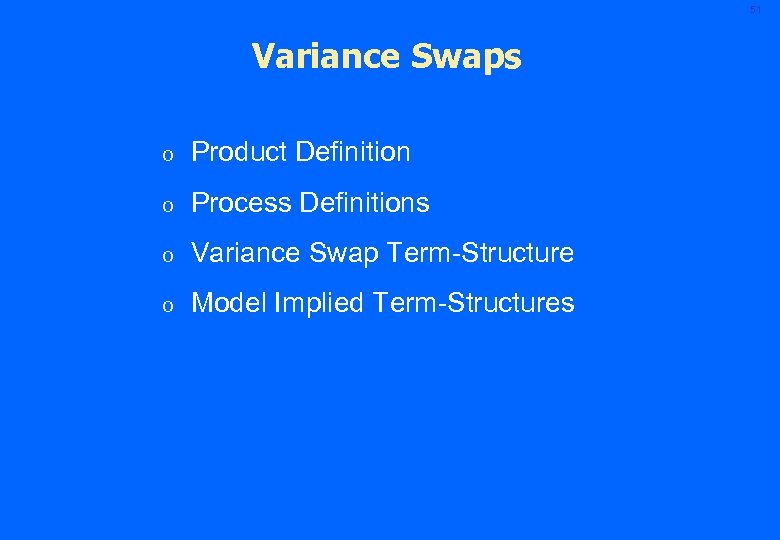 51 Variance Swaps o Product Definition o Process Definitions o Variance Swap Term-Structure o Model Implied Term-Structures
51 Variance Swaps o Product Definition o Process Definitions o Variance Swap Term-Structure o Model Implied Term-Structures
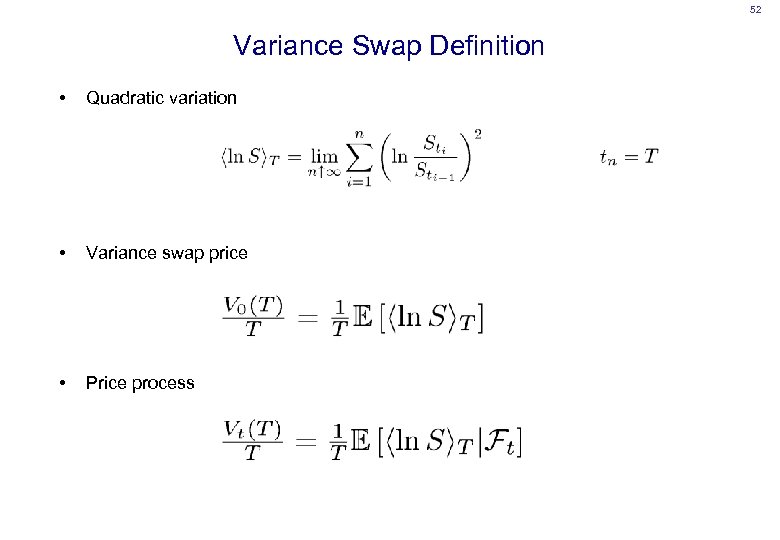 52 Variance Swap Definition • Quadratic variation • Variance swap price • Price process
52 Variance Swap Definition • Quadratic variation • Variance swap price • Price process
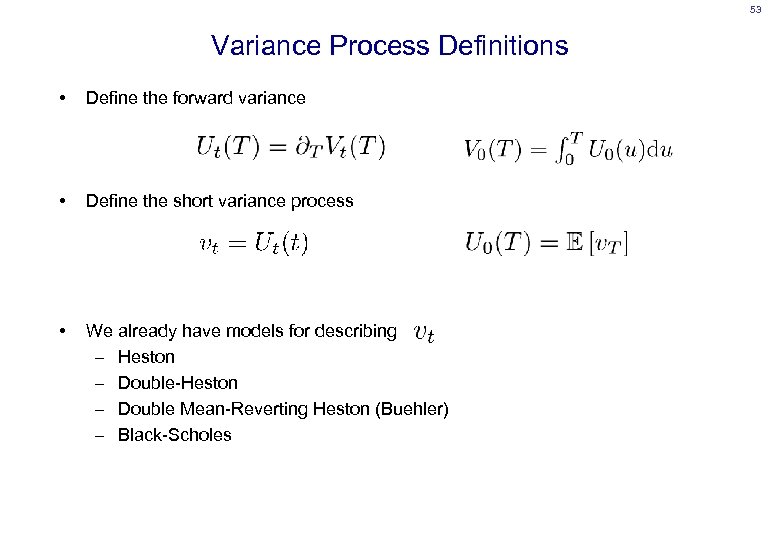 53 Variance Process Definitions • Define the forward variance • Define the short variance process • We already have models for describing – Heston – Double-Heston – Double Mean-Reverting Heston (Buehler) – Black-Scholes
53 Variance Process Definitions • Define the forward variance • Define the short variance process • We already have models for describing – Heston – Double-Heston – Double Mean-Reverting Heston (Buehler) – Black-Scholes
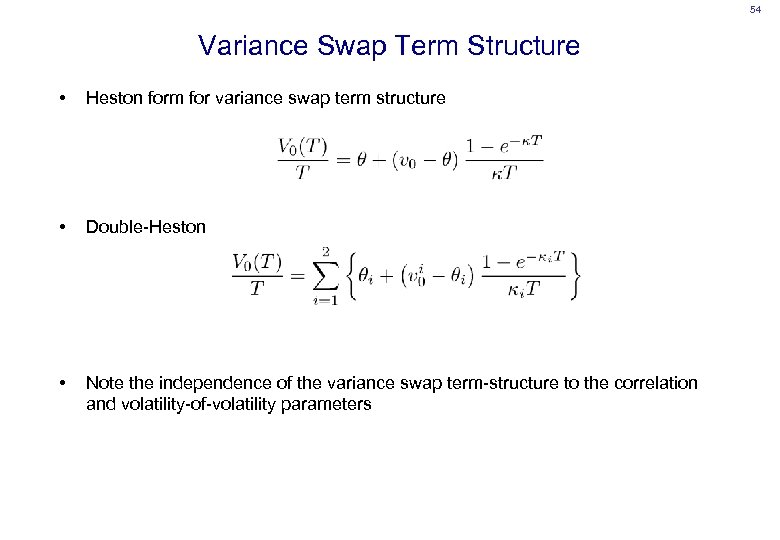 54 Variance Swap Term Structure • Heston form for variance swap term structure • Double-Heston • Note the independence of the variance swap term-structure to the correlation and volatility-of-volatility parameters
54 Variance Swap Term Structure • Heston form for variance swap term structure • Double-Heston • Note the independence of the variance swap term-structure to the correlation and volatility-of-volatility parameters
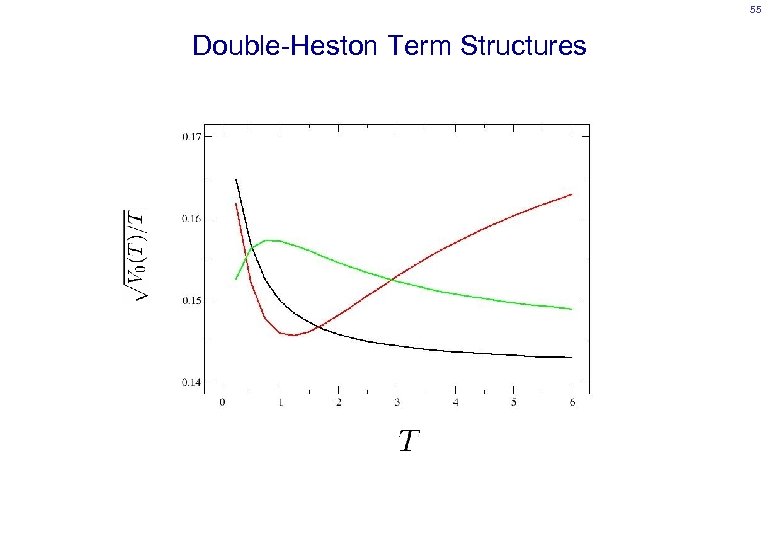 55 Double-Heston Term Structures
55 Double-Heston Term Structures
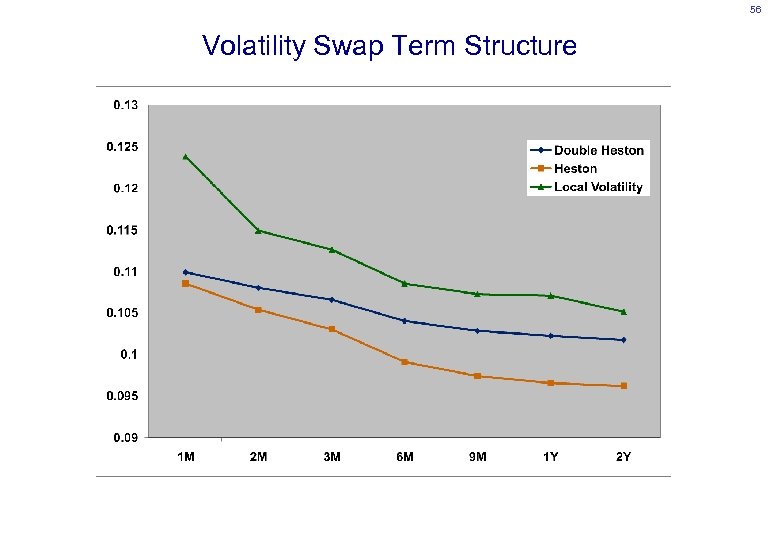 56 Volatility Swap Term Structure
56 Volatility Swap Term Structure
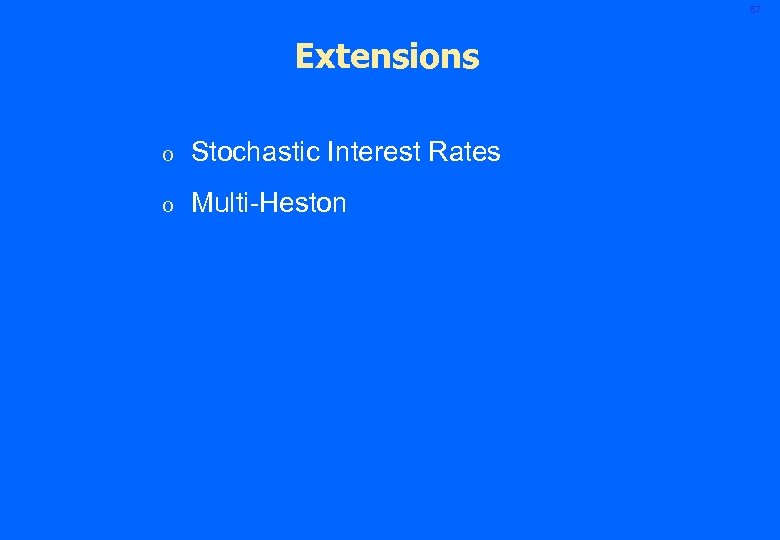 57 Extensions o Stochastic Interest Rates o Multi-Heston
57 Extensions o Stochastic Interest Rates o Multi-Heston
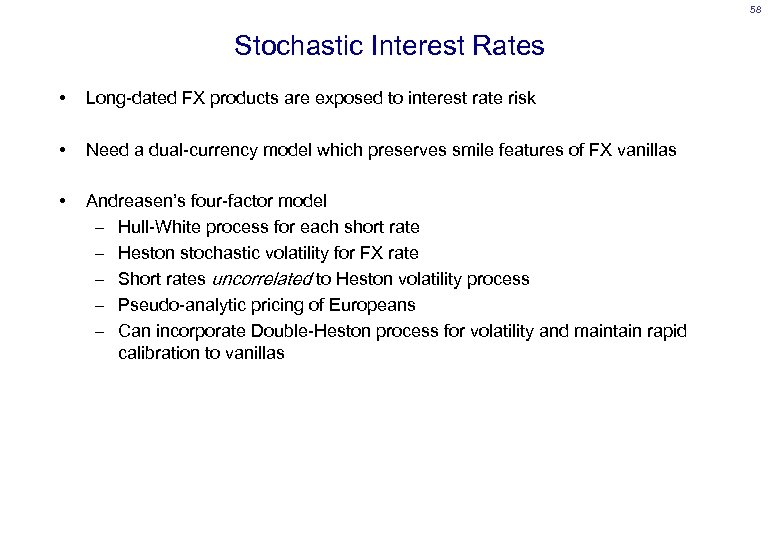 58 Stochastic Interest Rates • Long-dated FX products are exposed to interest rate risk • Need a dual-currency model which preserves smile features of FX vanillas • Andreasen’s four-factor model – Hull-White process for each short rate – Heston stochastic volatility for FX rate – Short rates uncorrelated to Heston volatility process – Pseudo-analytic pricing of Europeans – Can incorporate Double-Heston process for volatility and maintain rapid calibration to vanillas
58 Stochastic Interest Rates • Long-dated FX products are exposed to interest rate risk • Need a dual-currency model which preserves smile features of FX vanillas • Andreasen’s four-factor model – Hull-White process for each short rate – Heston stochastic volatility for FX rate – Short rates uncorrelated to Heston volatility process – Pseudo-analytic pricing of Europeans – Can incorporate Double-Heston process for volatility and maintain rapid calibration to vanillas
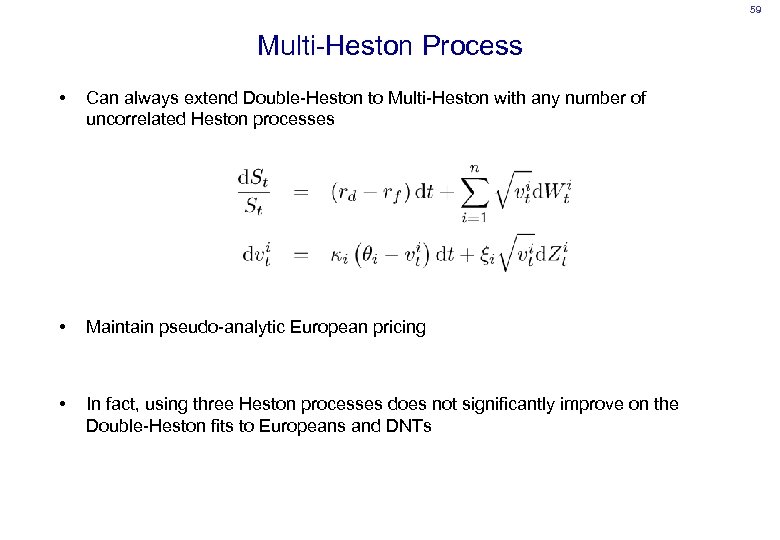 59 Multi-Heston Process • Can always extend Double-Heston to Multi-Heston with any number of uncorrelated Heston processes • Maintain pseudo-analytic European pricing • In fact, using three Heston processes does not significantly improve on the Double-Heston fits to Europeans and DNTs
59 Multi-Heston Process • Can always extend Double-Heston to Multi-Heston with any number of uncorrelated Heston processes • Maintain pseudo-analytic European pricing • In fact, using three Heston processes does not significantly improve on the Double-Heston fits to Europeans and DNTs
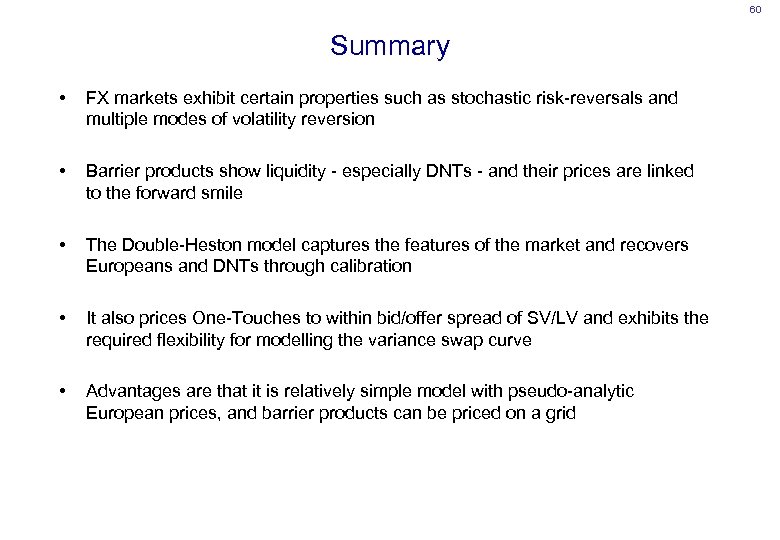 60 Summary • FX markets exhibit certain properties such as stochastic risk-reversals and multiple modes of volatility reversion • Barrier products show liquidity - especially DNTs - and their prices are linked to the forward smile • The Double-Heston model captures the features of the market and recovers Europeans and DNTs through calibration • It also prices One-Touches to within bid/offer spread of SV/LV and exhibits the required flexibility for modelling the variance swap curve • Advantages are that it is relatively simple model with pseudo-analytic European prices, and barrier products can be priced on a grid
60 Summary • FX markets exhibit certain properties such as stochastic risk-reversals and multiple modes of volatility reversion • Barrier products show liquidity - especially DNTs - and their prices are linked to the forward smile • The Double-Heston model captures the features of the market and recovers Europeans and DNTs through calibration • It also prices One-Touches to within bid/offer spread of SV/LV and exhibits the required flexibility for modelling the variance swap curve • Advantages are that it is relatively simple model with pseudo-analytic European prices, and barrier products can be priced on a grid
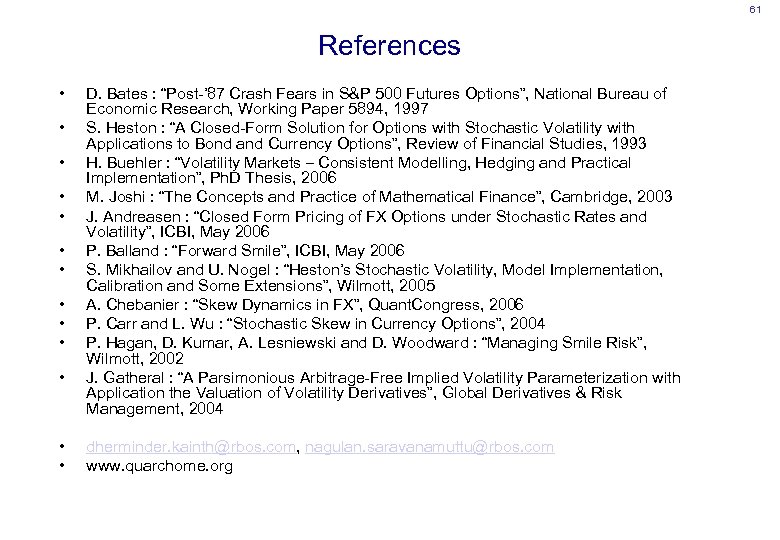 61 References • • • • D. Bates : “Post-’ 87 Crash Fears in S&P 500 Futures Options”, National Bureau of Economic Research, Working Paper 5894, 1997 S. Heston : “A Closed-Form Solution for Options with Stochastic Volatility with Applications to Bond and Currency Options”, Review of Financial Studies, 1993 H. Buehler : “Volatility Markets – Consistent Modelling, Hedging and Practical Implementation”, Ph. D Thesis, 2006 M. Joshi : “The Concepts and Practice of Mathematical Finance”, Cambridge, 2003 J. Andreasen : “Closed Form Pricing of FX Options under Stochastic Rates and Volatility”, ICBI, May 2006 P. Balland : “Forward Smile”, ICBI, May 2006 S. Mikhailov and U. Nogel : “Heston’s Stochastic Volatility, Model Implementation, Calibration and Some Extensions”, Wilmott, 2005 A. Chebanier : “Skew Dynamics in FX”, Quant. Congress, 2006 P. Carr and L. Wu : “Stochastic Skew in Currency Options”, 2004 P. Hagan, D. Kumar, A. Lesniewski and D. Woodward : “Managing Smile Risk”, Wilmott, 2002 J. Gatheral : “A Parsimonious Arbitrage-Free Implied Volatility Parameterization with Application the Valuation of Volatility Derivatives”, Global Derivatives & Risk Management, 2004 dherminder. kainth@rbos. com, nagulan. saravanamuttu@rbos. com www. quarchome. org
61 References • • • • D. Bates : “Post-’ 87 Crash Fears in S&P 500 Futures Options”, National Bureau of Economic Research, Working Paper 5894, 1997 S. Heston : “A Closed-Form Solution for Options with Stochastic Volatility with Applications to Bond and Currency Options”, Review of Financial Studies, 1993 H. Buehler : “Volatility Markets – Consistent Modelling, Hedging and Practical Implementation”, Ph. D Thesis, 2006 M. Joshi : “The Concepts and Practice of Mathematical Finance”, Cambridge, 2003 J. Andreasen : “Closed Form Pricing of FX Options under Stochastic Rates and Volatility”, ICBI, May 2006 P. Balland : “Forward Smile”, ICBI, May 2006 S. Mikhailov and U. Nogel : “Heston’s Stochastic Volatility, Model Implementation, Calibration and Some Extensions”, Wilmott, 2005 A. Chebanier : “Skew Dynamics in FX”, Quant. Congress, 2006 P. Carr and L. Wu : “Stochastic Skew in Currency Options”, 2004 P. Hagan, D. Kumar, A. Lesniewski and D. Woodward : “Managing Smile Risk”, Wilmott, 2002 J. Gatheral : “A Parsimonious Arbitrage-Free Implied Volatility Parameterization with Application the Valuation of Volatility Derivatives”, Global Derivatives & Risk Management, 2004 dherminder. kainth@rbos. com, nagulan. saravanamuttu@rbos. com www. quarchome. org


